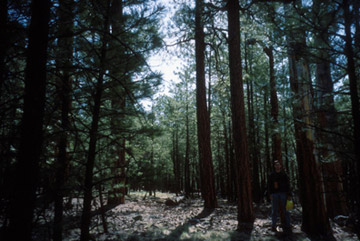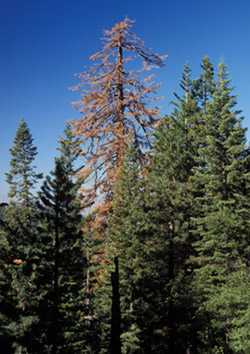|
|
Tree death rates in old-growth forests of the western United States have more more than doubled in recent decades likely because of regional climate warming, report researchers writing in the journal Science.
Analyzing records from undisturbed 200-year-old forests in the Pacific Northwest (Oregon, Washington, California, Arizona, Colorado, and New Mexico) and southern British Columbia, Phillip van Mantgem and colleagues found that trees are dying at ever greater rates. Worryingly, tree mortality rates are increasing for “trees of different sizes and types, growing at different elevations and in forests with different fire histories, suggesting that the changes are not simply due to increasing competition for resources or aging of large trees.”
The authors note that temperatures in the western United States have been increasing since 1970 and though they can’t say for certain that rising temperatures are the culprit, the scientists were able to rule out air pollution, long-term effects of fire suppression, and normal forest dynamics. The researchers speculate that climate change may be creating conditions that increase the susceptibility of trees to drought stress and pests.
 Photo of ponderosa pine trees taken in 2000 in Gus Pearson Natural Area, AZ. Photo by Justin Waskiewicz. |
“Average temperature in the West rose by more than 1°F over the last few decades,” said Phil van Mantgem, a U.S. Geological Survey (USGS) scientist and co-leader of the research team. “While this may not sound like much, it has been enough to reduce winter snowpack, cause earlier snowmelt, and lengthen the summer drought.”
“One degree warmer may not seem like a lot, but the effects can be cumulative and put many more trees under stress, and cause a few more trees to die than used to,” said study co-author Mark Harmon, professor of forest ecology at Oregon State University (OSU). “Over long periods of time that can change the whole composition of the forest.”
The authors warn that increased tree mortality can reduce the overall age of the forest, affecting its structure and suitability for certain species of wildlife.
 Sugar pine dying from bark beetle attack in Yosemite National Park. Image courtesy of Jerry Franklin |
“Our long-term monitoring shows that tree mortality has been climbing, while the establishment of replacement trees has not,” said van Mantgem.
In other words, forests are losing trees faster than they’re gaining them.
“Tree death rates are like interest on a bank account – the effects compound over time,” added team co-leader, Nate Stephenson, a USGS scientist. “A doubling of death rates eventually could reduce average tree age in a forest by half, thus reducing average tree size.”
The researchers add that increasing tree deaths may be an indication of a forest’s vulnerability to an abrupt, extensive die-back.
“That may be our biggest concern,” said Stephenson. “Is the trend we’re seeing a prelude to bigger, more abrupt changes to our forests?”
Die-offs may also contribute to a feedback loop — as trees die they release carbon dioxide into the atmosphere, further contributing to warming.
“The forests may stabilize at lower overall levels of biomass resulting in less carbon stored in the forests,” said co-author Andrew Larson, an OSU researcher.
P.J. van Mantgem et al. “Widespread Increase of Tree Mortality Rates in the Western United States,” SCIENCE VOL 323 23 JANUARY 2009